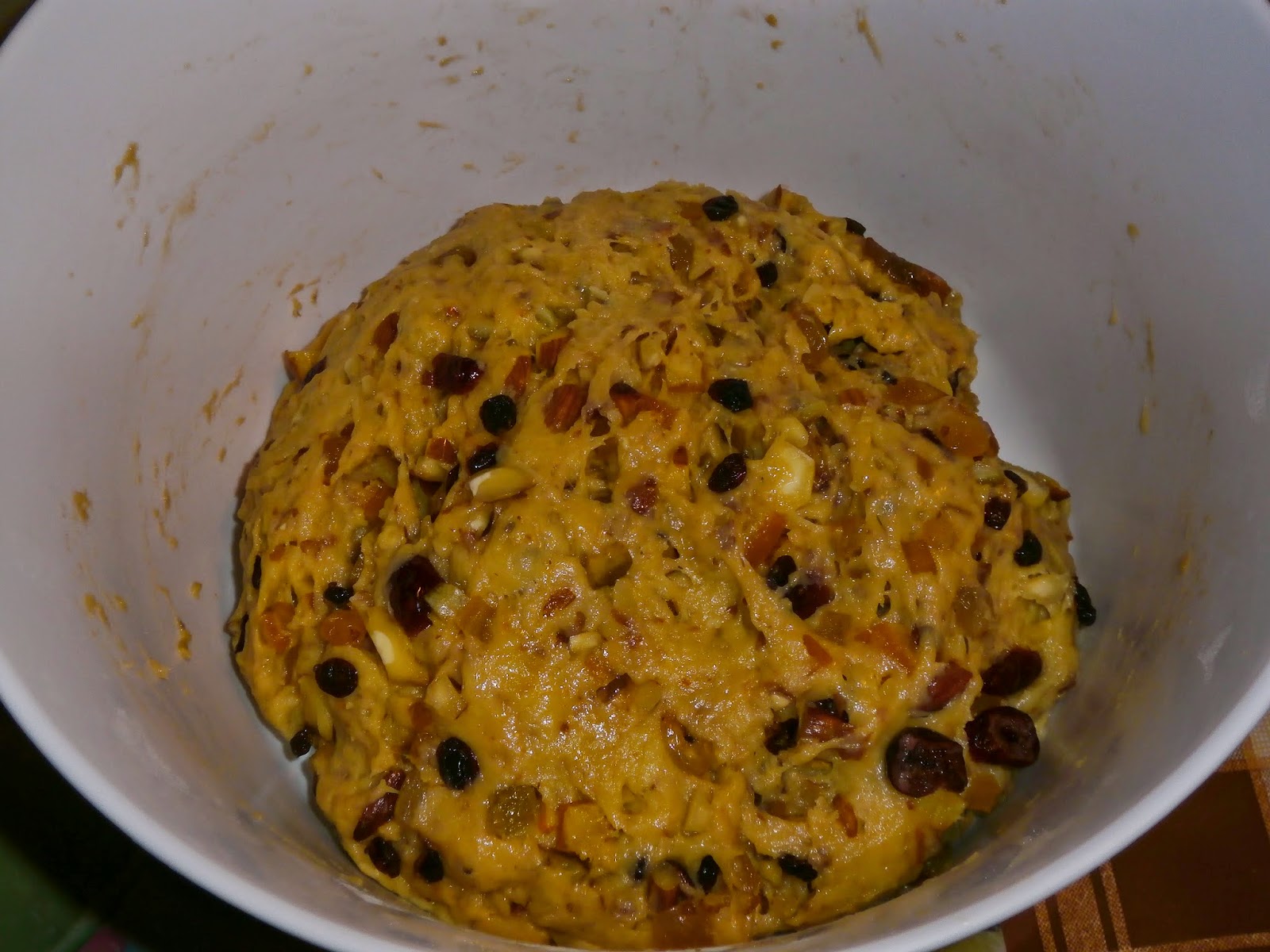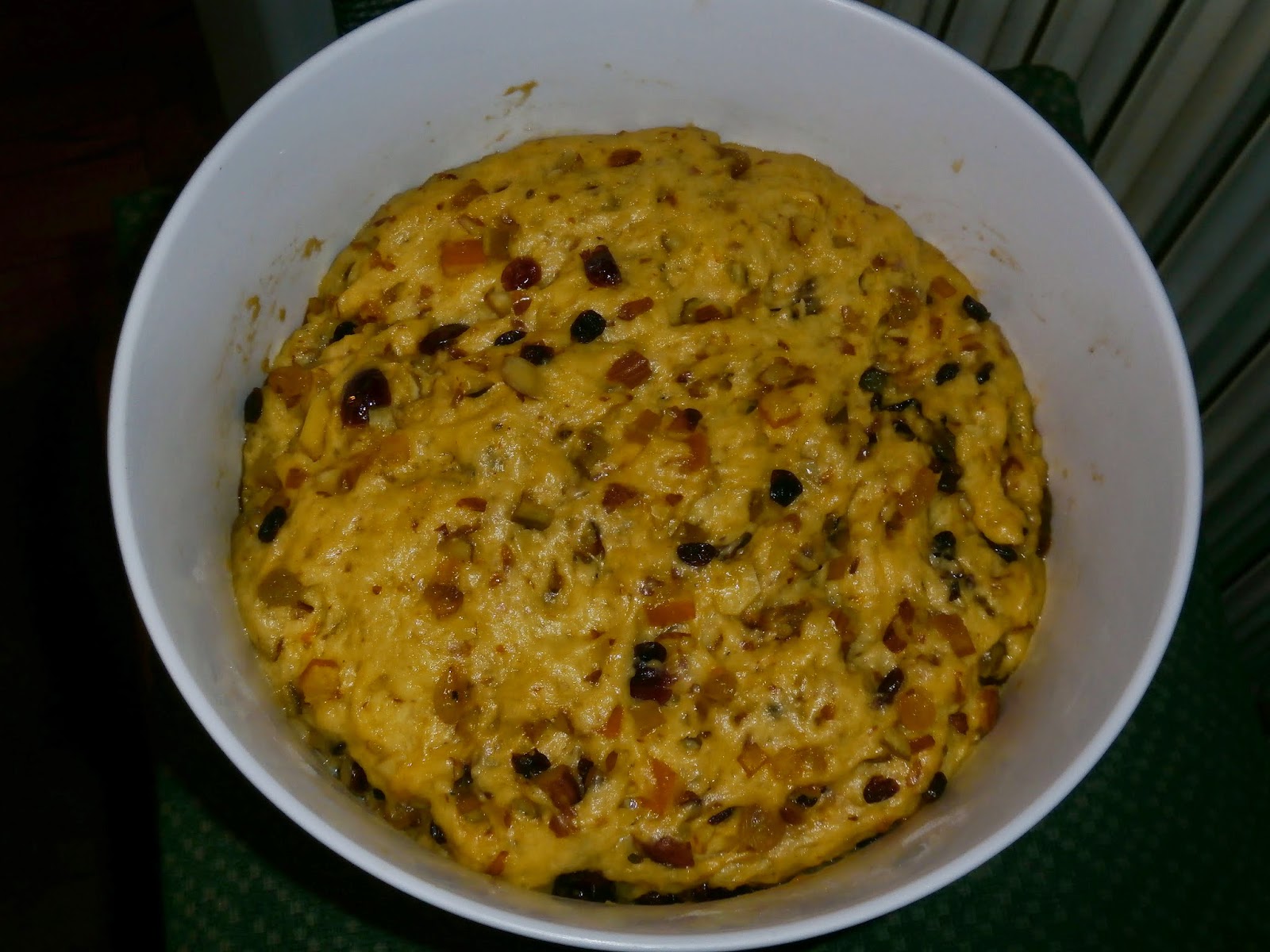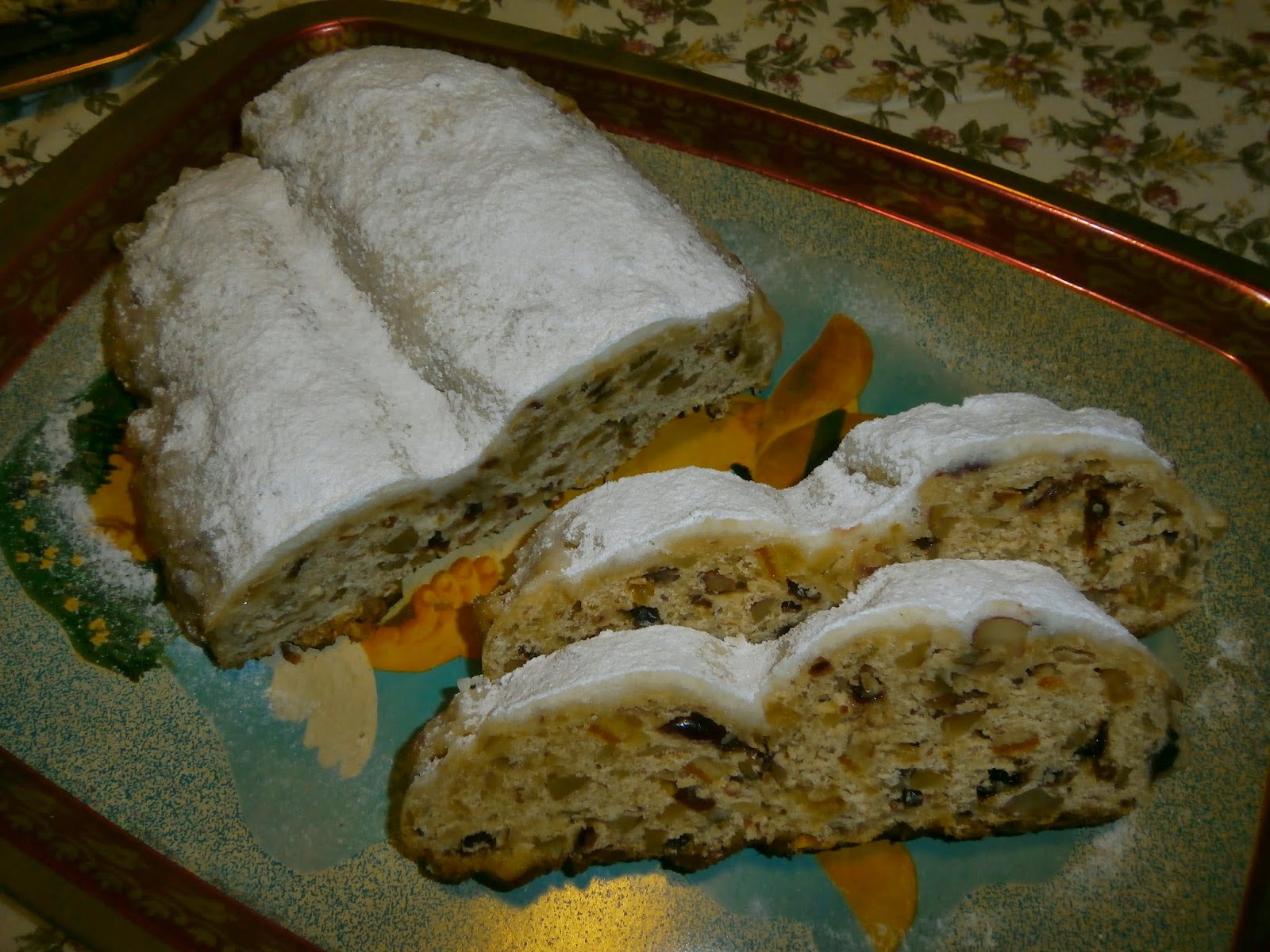Cele mai
mari emoţii legate de prăjiturile pentru sărbători le-am avut pentru
Christstollen, cozonacul german (originar din Dresda, unde există şi un
festival anual) cu stafide, fructe confiate, migdale şi, în unele variante,
marţipan. Dar sunt foarte foarte mulţumită de rezultat. Am urmat o reţetă de pe
un site german
şi am obţinut un stollen care aproape nu se deosebeşte de cel original, pe care
l-am adus din vacanţă – la înfăţişare, textură şi, foarte important, gust. Asta
mi-a înseninat ziua... şi sărbătorile!
CHRISTSTOLLEN
- 50 g stafide
- 50 g coacăze (sau alte fructe uscate)
- 50 g coajă confiată de portocală
- 50 g coajă confiată de lămâie (sau mix lămâie-lime)
- 5 linguri rom
- 140 g unt
- 350 g făină
- 7 g drojdie uscată
- 40 g zahăr
- ½ linguriţă extract de vanilie
- un vârf de sare
- coaja rasă de la o lămâie
- 2 ouă
- 150 g migdale bucăţi
- 80 ml lapte
- 100 g unt
- 100 g zahăr pudră
Punem stafidele, fructele uscate şi coaja confiată de citrice într-un castron.
Turnăm peste fructe romul şi lăsăm peste
noapte – romul nu va acoperi fructele, aşa că putem să le amestecăm puţin cu o
lingură, pentru ca toate fructele să prindă aroma.
A doua zi, amestecăm într-un castron mare
făina (cernută înainte), drojdia uscată, zahărul, sarea şi coaja de lămâie.
Topim untul şi îl lăsăm să se răcorească
puţin.
Rulăm partea mai mare (cele două treimi) până
la depresiune (sper că se înţelege mai bine din poze).
Punem stollen-ul cu grijă pe o tavă acoperită
cu foaie de copt (putem întinde aluatul direct în tavă, ca să ne fie mai uşor).
Coacem stollen-ul în cuptorul încins, la foc
potrivit, pe raftul din mijloc, cam 30 de minute – dacă marginile devin aurii,
iar scobitoarea iese curată, este făcut.
Când este aproape gata, topim cele 100 g unt.
Când este aproape gata, topim cele 100 g unt.
Înainte de
sevire, îl mai pudrăm puţin cu zahăr.
Poftă bună!
PS: Citisem
undeva că stollen-ul se taie de la jumătate spre capete, unind cele două bucăţi
de fiecare dată – aşa nu se va usca.
*********************************************************************************************
Of all the sweets I
made for these winter holidays, I was very nervous about the Christstollen, the
German cake (originating from Dresden, where an annual festival is dedicated to
this cake) with raisins, candied fruits, almonds and, in some versions,
marzipan. But I am very very happy about the result. I followed a recipe from a
german website
and obtained a stolen that is hard to be distinguished from the original, which
I brought from my holiday: looks, texture and, very important, taste – they are
so similar. Well, this achievement made my day… and holidays!
CHRISTSTOLLEN
- 50 g raisins
- 50 g currants (or other dried fruits)
- 50 g candied orange peel
- 50 g candied lemon peel (or a mix lemon-lime)
- 5 tablespoons rum
- 140 g butter
- 350 g flour
- 7 g dry yeast
- 40 g sugar
- ½ teaspoons vanilla
- a pinch of salt
- grated zest from one lemon
- 2 eggs
- 150 g chopped almonds
- 80 ml milk
- 100 g butter
- 100 g icing sugar
Place the raisins,
dried fruits and candied peel in a bowl.
Pour the rum and leave
overnight – the rum won’t cover the fruits, so you can use a spoon to mix them,
so that they all catch the flavor.
The second day, mix
flour (previously sifted), dry yeast, sugar, salt and lemon zest.
Melt the butter and
let it cool for a few minutes.
Heat the milk with
vanilla, until lukewarm.
Whisk the eggs lightly
and pour them over the flour, add the almonds and melted butter.
Start kneading and gradually pour
the milk.
Knead until smooth,
then leave it to rise, in a warm place, for 2 hours.
Drain the fruits and
add them to the dough. Knead to fold them in.
Leave it again to rise
for another 2 hours.
Put the dough on a working
board and shape it into an oval.
Make a depression with
your hand, over the entire length of the dough, at about one third of the edge.
Roll the larger side
(the two thirds) over the depression (see the photos above).
Carefully transfer the
stollen on a tray lined with parchment paper (you can make the stollen directly
on the tray, it will be easier).
Bake the stollen in
the preheated oven, to medium heat, on the middle shelf, for about 30 minutes –
if the margins are golden and the toothpick comes out clean, it’s done.
When almost done, melt
the 100 g butter.
Remove the stollen
from the oven as soon as it is done.
Brush it with butter
and sprinkle icing sugar. Repeat (butter, sugar) until you’ve finished the
melted butter and sugar.
Leave the stollen to
cool completely, then put it in a plastic bag – it will remain fluffy for a
long time (it really is tastier and juicier after 2-3 weeks, kept in a cool and
dry place).
Before serving, you
can sprinkle some more icing sugar on top.
Enjoy!
PS: I read somewhere
that stollen is to be sliced from the middle to the ends, each time putting
together the two halves – this way it won’t get dried.



















































Niciun comentariu:
Trimiteți un comentariu